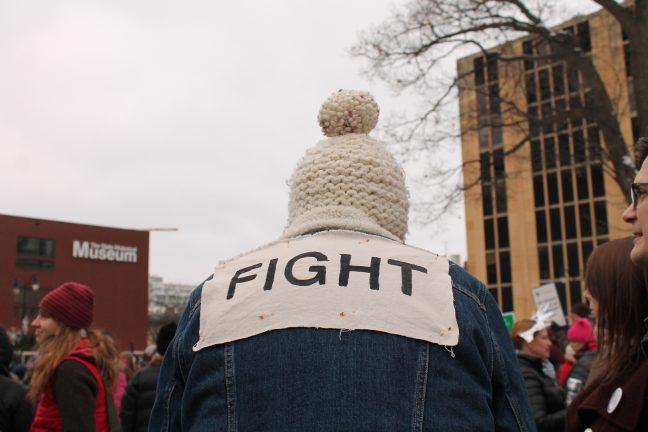Seven years ago, in the winter of 2011, I remember hearing rumors of canceled school — the teachers wouldn’t be there because they were striking. As Gov. Scott Walker brought forth his Budget Repair Bill, more infamously named Act 10 — a bill that would lower funding for educational programs and eliminate collective bargaining — thousands of people flocked to Madison to protest the measure at any cost.
In an unprecedented move, 14 Democratic lawmakers fled the state to delay the vote on the anti-union, anti-public-worker legislation. What ensued remains vividly seared into the brains of anyone that was in Madison over the period.
A multiple week seizure of the State Capitol, national (if not international) coverage, lots of singing of solidarity forever and ultimately, proof that protests in a Republican-controlled state are possible. This historic moment now acts effectively as a sign of what’s going on in West Virginia, and what will happen next month in Oklahoma.
Mass protest for teachers is nothing new or uncommon, but what’s different with West Virginia and Oklahoma is a general belief these states are too red or not the right place for progressive or labor politics. While places like Wisconsin (historically a state with one of the strongest progressive and labor traditions in the country), New York or Chicago carry an aura about politics akin to protests, states like West Virginia and Oklahoma don’t illicit these same thoughts.
But if we look back to the Democratic primaries in both West Virginia and Oklahoma, we see two states won by Bernie Sanders and it’s worth noting that people in these purportedly right-wing states voted for labor politics. A year and a half after the general presidential election, we see teachers and union workers are enthused and determined to fight for better pay and governmental support.
West Virginia public school teachers are rightfully distraught over their lackluster pay and over the increasing prioritization of private schools by Republican lawmakers. Similarly, there’s been a push to increase pay by cutting Medicaid, but West Virginia has the highest percentage of its population enrolled — 29 percent — and the consequences of its decimation would be momentously disastrous.
Additionally, there’s pushback over President Donald Trump’s comments that they could receive higher wages if teachers agreed to be armed.
Today, West Virginia Governor Jim Justice announced that he and the teachers agreed on a 5 percent increase of their salary, a goal public teachers were adamantly fighting for.
We have reached a deal. I stood rock solid on the 5% Teacher pay raise and delivered. Not only this, but my staff and I made additional cuts which will give all State employees 5% as well. All the focus should have always been on fairness and getting the kids back in school.
— Governor Jim Justice (@WVGovernor) March 6, 2018
In Oklahoma, a surge of social media activism regarding teacher wages and disappointment over a series of legislative failures has pushed teachers to follow suit, and begin strike.
According to a 2014 statute, it’s illegal for public workers to strike, but the fact that teachers strike regardless indicates an inexorable energy spreading across the country that isn’t being halted by laws or societal expectations.
While the Act 10 protests of 2011 and recall election against Governor Scott Walker in 2012 failed, they proved something to the rest of the country. Progress and fighting for better wages and quality of life is indelible. This notion is spreading across the nation, infiltrating the states most of us don’t consider particularly progressive. And for that, I salute you West Virginia and Oklahoma — solidarity now, and solidarity forever.
Adam Ramer (aramer2@wisc.edu) is a junior majoring in history and political science.


